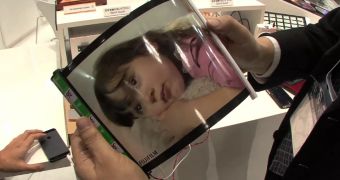Bendable, foldable and rollable displays have become reality, to a certain extent, but it takes much more than that to make flexible consumer electronics devices. Fujitsu has just provided one piece of the puzzle.
One might argue that audio output doesn't have much of a bearing on the ease, or lack thereof, of making a bendable device.
After all, speakers can come in very small sizes, so they could even be embedded in the edge of the rollable display or PCB.
Fujitsu doesn't want to do things by halves though. A report from Digitnfo TV has video proof.
Embedded below, the video shows what seems to be a rollable photograph, but which is, in truth, an electroacoustic film.
With elasticity dependent on frequency, it produces high-quality sound even while being bent in various ways.
"This film is normally soft, but it becomes hard in the audio frequency range. That's because it's designed so that, when the ceramic vibrates in the audio range, from 20 Hz to 20 kHz, the vibrational energy is transmitted to the entire film," Fujitsu explains, as quoted in the report.
As Fujitsu explains, the film has the same acoustic velocity and 2-3 times the internal loss of normal speakers with paper cones. That means high-quality sound.
That it doesn't break when folded in complicated ways, or when rolled in a tight stick so to speak, is another big advantage.
Previously, there were attempts at flexible polyvinylidene fluoride, a 100% polymer material that, unfortunately, tends to break.
The new material, which combines a ceramic with a polymer, doesn't break when used for low frequencies.
In conclusion, Fujitsu's electroacoustic film could work well with flexible OLED displays in future rollable phones, tablets, etc. No time frame is given for such things, nor for a marketable version of the audio film for that matter, but it helps to know that the foundation has been set.

 14 DAY TRIAL //
14 DAY TRIAL // 